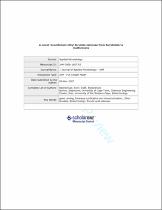JavaScript is disabled for your browser. Some features of this site may not work without it.
- ResearchSpace
- →
- Research Publications/Outputs
- →
- Journal Articles
- →
- View Item
| dc.contributor.author |
Rashamuse, KJ

|
|
| dc.contributor.author |
Burton, SG

|
|
| dc.contributor.author |
Cowan, DA

|
|
| dc.date.accessioned | 2009-05-07T14:20:19Z | |
| dc.date.available | 2009-05-07T14:20:19Z | |
| dc.date.issued | 2007-11 | |
| dc.identifier.citation | Rashamuse, KJ, Burton, SG and Cowan, DA. 2007. Novel recombinant ethyl ferulate esterase from Burkholderia multivorans. Journal of Applied Microbiology, Vol. (2007), pp 1-40 | en |
| dc.identifier.issn | 1364-5072 | |
| dc.identifier.uri | http://hdl.handle.net/10204/3358 | |
| dc.description | This is a Post-print version of the work. It is posted here by permission of Blackwell Publishing for your personal use. Not for redistribution | en |
| dc.description.abstract | Isolation and identification of bacterial isolates with specific ferulic acid (FA) esterase activity and cloning of a gene encoding activity. A micro-organism with ethyl ferulate hydrolysing (EFH) activity was isolated by culture enrichment techniques. Detailed molecular identification based on species-specific primers and two conserved genes (16S rRNA and recA) led to the identification of the isolate as Burkholderia multivorans UWC10. A gene (designated estEFH5) encoding an EFH enzyme was cloned and its nucleotide sequence determined. Translational analysis revealed that estEFH5 encoded a polypeptide of 326 amino acids with an estimated molecular weight of 34.83 kDa. The EstEFH5 primary structure showed a typical serine hydrolase motif (G-H-S-L-G). The estEFH5 gene was over-expressed in Escherichia coli in an insoluble form. Following urea denaturation and in vitro refolding, the enzyme was purified using one-step His Select™ Nickel chromatographic column. Purified EstEFH5 showed a preference for short-chain -nitrophenyl esters (C2 and C3) a typical feature for carboxylesterase. Furthermore, the recombinant enzyme also retained the activity against ethyl ferulate (EF). Significance and Impact of the Study: A biocatalytic process for the production of FA from EF as a model substrate was demonstrated. This is the first report that describes the cloning and expression of a gene encoding FA esterase activity from the genus Burkholderia | en |
| dc.language.iso | en | en |
| dc.publisher | Blackwell Publishing | en |
| dc.subject | Ethyl ferulate | en |
| dc.subject | Gene cloning | en |
| dc.subject | Burkholderia multivorans | en |
| dc.subject | Ferulic acid esterase | en |
| dc.subject | Esterase purification | en |
| dc.subject | Novel recombinant ethyl ferulate esterase | en |
| dc.subject | Microbiology | en |
| dc.title | Novel recombinant ethyl ferulate esterase from Burkholderia multivorans | en |
| dc.type | Article | en |
| dc.identifier.apacitation | Rashamuse, K., Burton, S., & Cowan, D. (2007). Novel recombinant ethyl ferulate esterase from Burkholderia multivorans. http://hdl.handle.net/10204/3358 | en_ZA |
| dc.identifier.chicagocitation | Rashamuse, KJ, SG Burton, and DA Cowan "Novel recombinant ethyl ferulate esterase from Burkholderia multivorans." (2007) http://hdl.handle.net/10204/3358 | en_ZA |
| dc.identifier.vancouvercitation | Rashamuse K, Burton S, Cowan D. Novel recombinant ethyl ferulate esterase from Burkholderia multivorans. 2007; http://hdl.handle.net/10204/3358. | en_ZA |
| dc.identifier.ris | TY - Article AU - Rashamuse, KJ AU - Burton, SG AU - Cowan, DA AB - Isolation and identification of bacterial isolates with specific ferulic acid (FA) esterase activity and cloning of a gene encoding activity. A micro-organism with ethyl ferulate hydrolysing (EFH) activity was isolated by culture enrichment techniques. Detailed molecular identification based on species-specific primers and two conserved genes (16S rRNA and recA) led to the identification of the isolate as Burkholderia multivorans UWC10. A gene (designated estEFH5) encoding an EFH enzyme was cloned and its nucleotide sequence determined. Translational analysis revealed that estEFH5 encoded a polypeptide of 326 amino acids with an estimated molecular weight of 34.83 kDa. The EstEFH5 primary structure showed a typical serine hydrolase motif (G-H-S-L-G). The estEFH5 gene was over-expressed in Escherichia coli in an insoluble form. Following urea denaturation and in vitro refolding, the enzyme was purified using one-step His Select™ Nickel chromatographic column. Purified EstEFH5 showed a preference for short-chain -nitrophenyl esters (C2 and C3) a typical feature for carboxylesterase. Furthermore, the recombinant enzyme also retained the activity against ethyl ferulate (EF). Significance and Impact of the Study: A biocatalytic process for the production of FA from EF as a model substrate was demonstrated. This is the first report that describes the cloning and expression of a gene encoding FA esterase activity from the genus Burkholderia DA - 2007-11 DB - ResearchSpace DP - CSIR KW - Ethyl ferulate KW - Gene cloning KW - Burkholderia multivorans KW - Ferulic acid esterase KW - Esterase purification KW - Novel recombinant ethyl ferulate esterase KW - Microbiology LK - https://researchspace.csir.co.za PY - 2007 SM - 1364-5072 T1 - Novel recombinant ethyl ferulate esterase from Burkholderia multivorans TI - Novel recombinant ethyl ferulate esterase from Burkholderia multivorans UR - http://hdl.handle.net/10204/3358 ER - | en_ZA |






